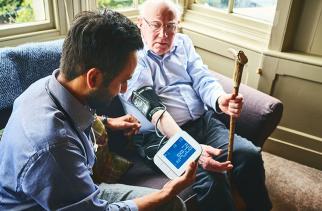Senior onderzoeker Huisartsenzorg
Publicatie
Publicatie datum
Declining number of home visits to older adults by general practitioners - an observational study using data from electronic health records in the Netherlands; 2017-2023.
Leemrijse, C.J., Heins, M.J., Knottnerus, B.J., Hooiveld, M., Boer, J.N. de, Schipper, R.F., Vanhommerig, J.W. Declining number of home visits to older adults by general practitioners - an observational study using data from electronic health records in the Netherlands; 2017-2023. BJGP Open: 2025
Lees online
Background
Despite an aging population that have higher care demand, home visits by general practitioners (GPs) have been declining.
Aim
To analyze the number of GP home visits from 2017 to 2023 in the Netherlands, and to investigate whether this trend differed according to age, sex, multimorbidity, and neighborhood deprivation. In addition, the most common reasons for home visits between 2017 and 2023 are presented.
Design & setting
Data were derived from Nivel Primary Care Database (Nivel-PCD), containing routinely recorded data from approximately 500 Dutch GP practices.
Method
The number of home visits was calculated by age, sex, multimorbidity, and neighborhood deprivation. Visual inspection was used to investigate the relation between the trend in number of home visits and age, sex, multimorbidity, and neighborhood deprivation of patients.
Results
A large decrease in the overall number of home visits was observed between 2017 and 2023 (-32%). The largest decrease was between 2019 and 2020, (-15%), but the downward trend continued in 2021 through 2023 (-5% per year). The most profound decline between 2023 and 2017 was found in the number of short home visits (-52%). The number of home visits for intensive GP care increased by 12% between 2017 and 2023.
Conclusion
We report a continuing decline in the number of home visits by GPs, comparing 2023 to 2017. Home visits for intensive GP care, often for patients at the end of life, increased since 2017. GPs may be forced to make choices due to the increasing workload.
Despite an aging population that have higher care demand, home visits by general practitioners (GPs) have been declining.
Aim
To analyze the number of GP home visits from 2017 to 2023 in the Netherlands, and to investigate whether this trend differed according to age, sex, multimorbidity, and neighborhood deprivation. In addition, the most common reasons for home visits between 2017 and 2023 are presented.
Design & setting
Data were derived from Nivel Primary Care Database (Nivel-PCD), containing routinely recorded data from approximately 500 Dutch GP practices.
Method
The number of home visits was calculated by age, sex, multimorbidity, and neighborhood deprivation. Visual inspection was used to investigate the relation between the trend in number of home visits and age, sex, multimorbidity, and neighborhood deprivation of patients.
Results
A large decrease in the overall number of home visits was observed between 2017 and 2023 (-32%). The largest decrease was between 2019 and 2020, (-15%), but the downward trend continued in 2021 through 2023 (-5% per year). The most profound decline between 2023 and 2017 was found in the number of short home visits (-52%). The number of home visits for intensive GP care increased by 12% between 2017 and 2023.
Conclusion
We report a continuing decline in the number of home visits by GPs, comparing 2023 to 2017. Home visits for intensive GP care, often for patients at the end of life, increased since 2017. GPs may be forced to make choices due to the increasing workload.
Background
Despite an aging population that have higher care demand, home visits by general practitioners (GPs) have been declining.
Aim
To analyze the number of GP home visits from 2017 to 2023 in the Netherlands, and to investigate whether this trend differed according to age, sex, multimorbidity, and neighborhood deprivation. In addition, the most common reasons for home visits between 2017 and 2023 are presented.
Design & setting
Data were derived from Nivel Primary Care Database (Nivel-PCD), containing routinely recorded data from approximately 500 Dutch GP practices.
Method
The number of home visits was calculated by age, sex, multimorbidity, and neighborhood deprivation. Visual inspection was used to investigate the relation between the trend in number of home visits and age, sex, multimorbidity, and neighborhood deprivation of patients.
Results
A large decrease in the overall number of home visits was observed between 2017 and 2023 (-32%). The largest decrease was between 2019 and 2020, (-15%), but the downward trend continued in 2021 through 2023 (-5% per year). The most profound decline between 2023 and 2017 was found in the number of short home visits (-52%). The number of home visits for intensive GP care increased by 12% between 2017 and 2023.
Conclusion
We report a continuing decline in the number of home visits by GPs, comparing 2023 to 2017. Home visits for intensive GP care, often for patients at the end of life, increased since 2017. GPs may be forced to make choices due to the increasing workload.
Despite an aging population that have higher care demand, home visits by general practitioners (GPs) have been declining.
Aim
To analyze the number of GP home visits from 2017 to 2023 in the Netherlands, and to investigate whether this trend differed according to age, sex, multimorbidity, and neighborhood deprivation. In addition, the most common reasons for home visits between 2017 and 2023 are presented.
Design & setting
Data were derived from Nivel Primary Care Database (Nivel-PCD), containing routinely recorded data from approximately 500 Dutch GP practices.
Method
The number of home visits was calculated by age, sex, multimorbidity, and neighborhood deprivation. Visual inspection was used to investigate the relation between the trend in number of home visits and age, sex, multimorbidity, and neighborhood deprivation of patients.
Results
A large decrease in the overall number of home visits was observed between 2017 and 2023 (-32%). The largest decrease was between 2019 and 2020, (-15%), but the downward trend continued in 2021 through 2023 (-5% per year). The most profound decline between 2023 and 2017 was found in the number of short home visits (-52%). The number of home visits for intensive GP care increased by 12% between 2017 and 2023.
Conclusion
We report a continuing decline in the number of home visits by GPs, comparing 2023 to 2017. Home visits for intensive GP care, often for patients at the end of life, increased since 2017. GPs may be forced to make choices due to the increasing workload.
Gegevensverzameling






